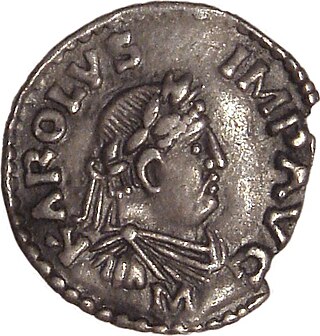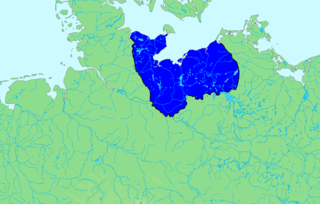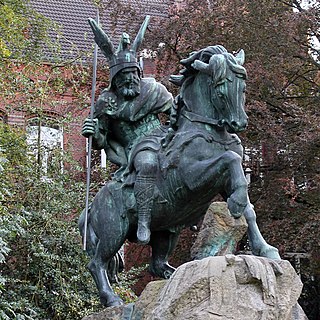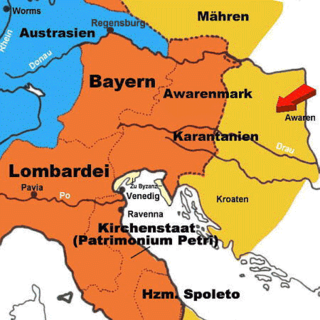Related Research Articles

Brandenburg, officially the State of Brandenburg, is a state in northeastern Germany. Brandenburg borders Poland and the states of Berlin, Mecklenburg-Vorpommern, Lower Saxony, Saxony-Anhalt, and Saxony. It is the fifth-largest German state by area and the tenth-most populous, with 2.5 million residents. Potsdam is the state capital and largest city. Other major towns are Cottbus, Brandenburg an der Havel and Frankfurt (Oder).

Charlemagne was King of the Franks from 768, King of the Lombards from 774, and Emperor of what is now known as the Carolingian Empire from 800, holding these titles until his death in 814. He united most of Western and Central Europe, and was the first recognised emperor to rule from the west after the fall of the Western Roman Empire approximately three centuries earlier. Charlemagne's reign was marked by political and social changes that had lasting influence on Europe throughout the Middle Ages.

Wends is a historical name for Slavs who inhabited present-day northeast Germany. It refers not to a homogeneous people, but to various people, tribes or groups depending on where and when it was used. In the modern day, communities identifying as Wendish exist in Slovenia, Austria, Lusatia, the United States, and Australia.

The Obotrites or Obodrites, also spelled Abodrites, were a confederation of medieval West Slavic tribes within the territory of modern Mecklenburg and Holstein in northern Germany. For decades, they were allies of Charlemagne in his wars against the Germanic Saxons and the Slavic Veleti. The Obotrites under Prince Thrasco defeated the Saxons in the Battle of Bornhöved (798). The still-Pagan Saxons were dispersed by the emperor, and the part of their former land in Holstein north of Elbe was awarded to the Obotrites in 804, as a reward for their victory. This however was soon reverted through an invasion of the Danes. The Obotrite regnal style was abolished in 1167, when Pribislav was restored to power by Duke Henry the Lion, as Prince of Mecklenburg, thereby founding the Germanized House of Mecklenburg.

Widukind, also known as Wittekind and Wittikund, was a leader of the Saxons and the chief opponent of the Frankish king Charlemagne during the Saxon Wars from 777 to 785. Charlemagne ultimately prevailed, organized Saxony as a Frankish province, massacred thousands of Saxon nobles, and ordered conversions of the pagan Saxons to Christianity. In later times, Widukind became a symbol of Saxon independence and a figure of legend. He is also venerated as a blessed in the Catholic Church.

Brandenburg an der Havel is a town in Brandenburg, Germany, which served as the capital of the Margraviate of Brandenburg until it was replaced by Berlin in 1417.

The Northern March or North March was created out of the division of the vast Marca Geronis in 965. It initially comprised the northern third of the Marca and was part of the territorial organisation of areas conquered from the Wends. A Lutician rebellion in 983 reversed German control over the region until the establishment of the March of Brandenburg by Albert the Bear in the 12th century.

The West Slavic languages are a subdivision of the Slavic language group. They include Polish, Czech, Slovak, Kashubian, Silesian, Upper Sorbian and Lower Sorbian. The languages have traditionally been spoken across a mostly continuous region encompassing the Czech Republic, Slovakia, Poland, the westernmost regions of Ukraine and Belarus, and a bit of eastern Lithuania. In addition, there are several language islands such as the Sorbian areas in Lusatia in Germany, and Slovak areas in Hungary and elsewhere.

Polabian Slavs, also known as Elbe Slavs and more broadly as Wends, is a collective term applied to a number of Lechitic tribes who lived scattered along the Elbe river in what is today eastern Germany. The approximate territory stretched from the Baltic Sea in the north, the Saale and the Limes Saxoniae in the west, the Ore Mountains and the Western Sudetes in the south, and Poland in the east.

Demmin is a town in the Mecklenburgische Seenplatte district, Mecklenburg-Western Pomerania, in north-eastern Germany. It was the capital of the former district of Demmin.

The Veleti, also known as Veletians, Wilzi, Wielzians, and Wiltzes, were a group of medieval Lechitic tribes within the territory of Western Pomerania, related to Polabian Slavs. They had formed together the Confederation of the Veleti, also known as the Union of the Veleti, a loose monarchic confederation of the tribes. Said state existed between the 6th and 10th centuries, after which, it was succeeded by the Lutician Federation.
Thrasco (*Daržĭkŭ) was the Prince (knyaz) of the Obotrite confederation from 795 until his death in 810. He succeeded his father, Witzlaus II, who had been ambushed and killed by the revolting Saxons. Thrasco defeated the Saxons in the battle on Schwentine River in 798. He was murdered in Reric in 810. Thrasco had a son, Cedragus, the Obotrite prince from 819 to 826.

The Avar March was a southeastern frontier province of the Frankish Empire, established after successful Frankish campaigns and conquests of Avarian territories along the river Danube, to the east from the river Enns, in what is today Lower Austria and northwestern Hungary. Since the Frankish conquest in the late 8th century, there were several administrative changes in those regions. Territory along the river Danube, from the river Enns to the Vienna Woods, was ruled directly, as a frontier extension (march) of the Frankish Bavaria, while regions further to the east, up to the river Rába, were initially designated to remaining Avarian princes, under the Frankish supreme rule. During the 820s and 830s, additional administrative changes were made in the wider region of Frankish Pannonia, inhabited mainly by Pannonian Slavs. Territories of the remaining Avarian princes were fully incorporated, and Avars eventually disappeared from the region.
The Nakonids were the leading noble family of the Slavic peoples of the Elbe River from ca. 960 until 1129. They were themselves of Obotrite origin and engineered the formation of a Slavic principality in the region. They became extinct in the male line in the early 12th century. Their capital was Mecklenburg Castle.

Pomerania during the Early Middle Ages covers the History of Pomerania from the 7th to the 11th centuries.
The Wolinians were a Lechitic tribe in Early Middle Age Pomerania. They were first mentioned as "Velunzani" with 70 civitates by the Bavarian Geographer, ca. 845. Associated with both the Veleti and the Pomeranians, they were based on the island of Wolin and the adjacent mainland. Compared to other tribes of these groups, the Wolinians' territory was relatively small but densely settled: in the 11th century, there was one settlement per four square kilometers. The Wolinians are described by Jan Maria Piskorski as the most powerful Pomeranian tribe. This position resulted from the multi-ethnic emporium at the site of the present-day town of Wolin (Wollin), then known as Jomsborg, Jumne, Julin or Vineta.

The Lutici or Liutizi(known by various spelling variants) were a federation of West Slavic Polabian tribes, who between the 10th and 12th centuries lived in what is now northeastern Germany. Four tribes made up the core of the federation: the Redarians, Circipanians (Circipani), Kessinians and Tollensians (Tholenzi). At least in part, the Lutici were a continuation of the Veleti. In contrast to the former and the neighboring peoples, the Lutici were not led by a Christian monarch or duke, rather power was asserted through consensus formed in central assemblies of the social elites, and the Lutici worshipped nature and several deities. The political and religious center was Radgosc.

Ostsiedlung is the term for the Early Medieval and High Medieval migration of ethnic Germans and Germanization of the areas populated by Slavic, Baltic and Uralic peoples; the most settled area was known as Germania Slavica. Germanization efforts included eastern parts of Francia, East Francia, and the Holy Roman Empire and beyond; and the consequences for settlement development and social structures in the areas of settlement. Other regions were also settled, though not as heavily. The Ostsiedlung encompassed multiple modern and historical regions, primarily Germany east of the Saale and Elbe rivers, the states of Lower Austria and Styria in Austria, Poland and the Czech Republic, but also in other parts of Central and Eastern Europe.

The Sorbs, also known as Serbs or White Serbs in Serbian historiography, were an Early Slavic tribe settled between the Saale-Elbe valley and the Lusatian Neisse. They were part of the Polabian Slavs and Wends group of Early Slavs. In the 7th century CE, the tribe joined Samo's Empire, and some Sorbs emigrated from their homeland to Southeast Europe. The tribe is last mentioned in the late-10th century, but its descendants can be found among Germanized people of Saxony, among the Slavic ethnic group of the Sorbs in Lusatia, and among the Serbs of Southeastern Europe.

A zhrets is a priest in the Slavic religion whose name is reconstructed to mean "one who makes sacrifices". The name appears mainly in the East and South Slavic vocabulary, while in the West Slavs it is attested only in Polish. Most information about the Slavic priesthood comes from Latin texts about the paganism of the Polabian Slavs. The descriptions show that they were engaged in offering sacrifices to the gods, divination and determining the dates of festivals. They possessed cosmological knowledge and were a major source of resistance against Christianity.
References
- ↑ Kazimierz Wachowski, Gerard Labuda: Słowiańszczyzna zachodnia. Poznań: Wydawnictwo Poznańskiego Towarzystwa Przyjaciól Nauk, 2000, p. 67. ISBN 9788370632717. (in Polish)
- 1 2 "Slawenfürsten" (in German).
- ↑ Schenker, Alexander M. (1901). An Introduction to Slavic Philology (PDF). New Haven and London: Yale University Press. p. 46. Archived from the original (PDF) on 2012-02-12. Retrieved 2010-07-30.
- ↑ Riché, Pierre (1993). The Carolingians: A Family Who Forged Europe. Philadelphia: University of Pennsylvania Press. p. 110. ISBN 0812213424.
- ↑ Oman, Sir Charles William Chadwick (1901). Dark Ages, 476-918 (Fourth ed.). London: Rivingtons. p. 360.
- ↑ "Dragowit: Fürst der Wilzen" (in German). Archived from the original on 2011-05-25. Retrieved 2010-07-30.